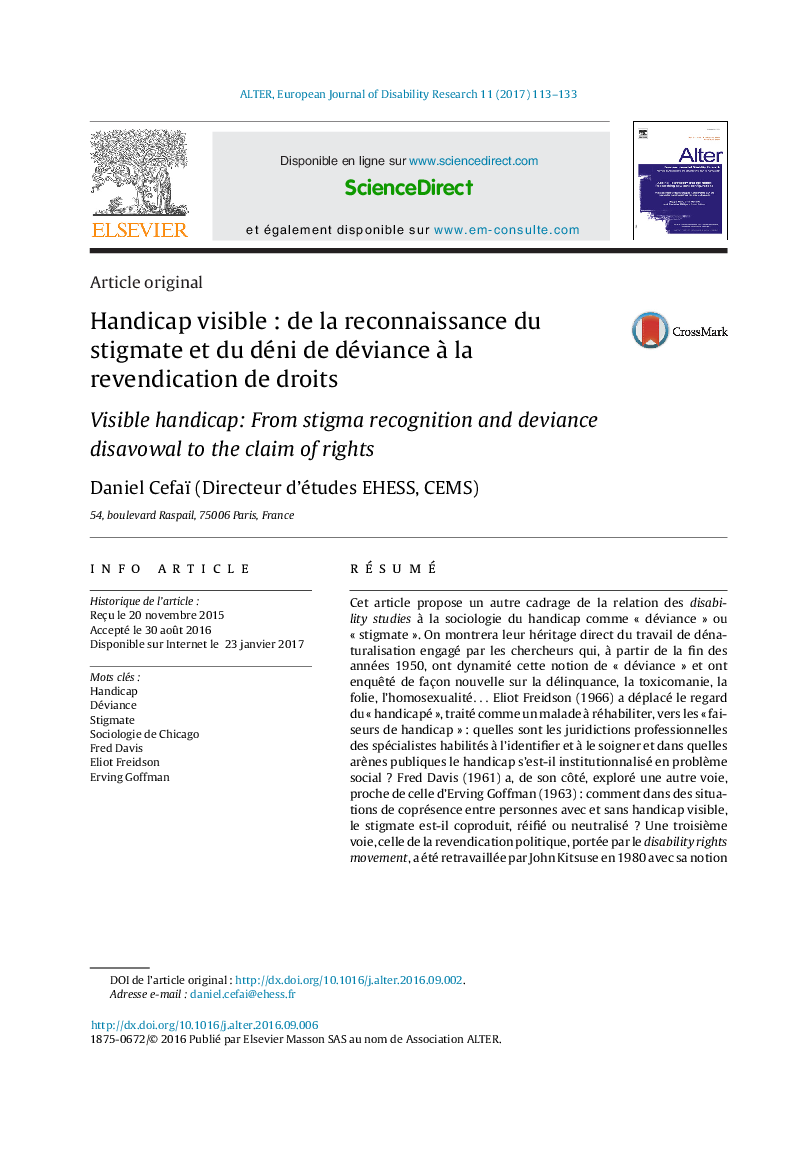| کد مقاله | کد نشریه | سال انتشار | مقاله انگلیسی | نسخه تمام متن |
|---|---|---|---|---|
| 5119811 | 1378234 | 2017 | 21 صفحه PDF | دانلود رایگان |

RésuméCet article propose un autre cadrage de la relation des disability studies à la sociologie du handicap comme « déviance » ou « stigmate ». On montrera leur héritage direct du travail de dénaturalisation engagé par les chercheurs qui, à partir de la fin des années 1950, ont dynamité cette notion de « déviance » et ont enquêté de façon nouvelle sur la délinquance, la toxicomanie, la folie, l'homosexualité⦠Eliot Freidson (1966) a déplacé le regard du « handicapé », traité comme un malade à réhabiliter, vers les « faiseurs de handicap » : quelles sont les juridictions professionnelles des spécialistes habilités à l'identifier et à le soigner et dans quelles arènes publiques le handicap s'est-il institutionnalisé en problème social ? Fred Davis (1961) a, de son côté, exploré une autre voie, proche de celle d'Erving Goffman (1963) : comment dans des situations de coprésence entre personnes avec et sans handicap visible, le stigmate est-il coproduit, réifié ou neutralisé ? Une troisième voie, celle de la revendication politique, portée par le disability rights movement, a été retravaillée par John Kitsuse en 1980 avec sa notion de « déviance tertiaire ». Tout en assumant l'héritage des années 1960, ce concept prend acte de la capacité d'agir des personnes en situation de handicap, de revendiquer des droits, d'inventer une expérience collective et d'aménager des environnements de vie.
This article brings new insight into the relationship between disability studies and the sociology of handicap as “deviance” and “stigma”. Disability studies grew up in a tight connection with the disability rights movement, but one of their roots was the new way of conceiving delinquency, addiction, madness, homosexuality, and handicap, which emerged in the 1960s. Eliot Freidson (1966) shifted the attention from the “disabled”, treated as patients to rehabilitate, to “handicap makers”. The relevant question was then: which are the professional jurisdictions of specialists appointed to “cure” disabled people? In which organizational arenas is disability institutionalized as a problem to be solved? Fred Davis (1961), for his part, explored another dimension, closer to Erving Goffman (1963): how are stigma co-produced, reified, or denied in encounter situations between people with and without disabilities? More specifically, how is the “visible handicap” handled in such face-to-face interactions? A third way has been worked by John Kitsuse in 1980Â with his concept of “tertiary deviance.” In line with the 1960s sociology of deviance as “secondary deviation”, this concept of “tertiary deviance” recognizes the ability of persons with disabilities to act, to claim rights, to invent collective identities, and to experience and create new life ecologies.
Journal: ALTER - European Journal of Disability Research / Revue Européenne de Recherche sur le Handicap - Volume 11, Issue 2, AprilâJune 2017, Pages 113-133